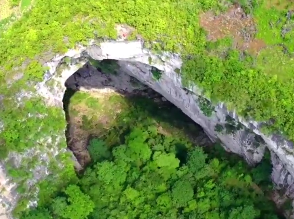Chinese scientists find massive 630ft-deep sinkhole with an entire hidden forest inside
Sinkhole has trees as tall as 131ft with species possibly not been seen before
Your support helps us to tell the story
From reproductive rights to climate change to Big Tech, The Independent is on the ground when the story is developing. Whether it's investigating the financials of Elon Musk's pro-Trump PAC or producing our latest documentary, 'The A Word', which shines a light on the American women fighting for reproductive rights, we know how important it is to parse out the facts from the messaging.
At such a critical moment in US history, we need reporters on the ground. Your donation allows us to keep sending journalists to speak to both sides of the story.
The Independent is trusted by Americans across the entire political spectrum. And unlike many other quality news outlets, we choose not to lock Americans out of our reporting and analysis with paywalls. We believe quality journalism should be available to everyone, paid for by those who can afford it.
Your support makes all the difference.A massive 630ft-deep sinkhole has been found in China in which a stunning ancient forest range has been discovered by researchers with trees as tall as 131ft (40m) and could include species that have not been seen before.
Cave explorers came across the sinkhole near Ping’e village in Leye County of the Guangxi Zhuang Autonomous Region earlier this month.
The sinkhole is 630ft (192m) deep and measures 1,000ft (304m) in length and 490ft (149m) in width, according to the Xinhua news agency.
The discovery was classified as “large” and experts hiked for several hours before reaching the base of the sinkhole and found three cave entrances.
The sinkhole’s bottom is lined with a “well-preserved primitive forest” with the trees growing up towards the sun, according to experts quoted by the news agency.
Chen Lixin, who led the cave expedition team, told Xinhua that the dense undergrowth on the sinkhole floor was as high as a person’s shoulders and that some of the ancient trees at the bottom were 131ft (40m) tall.
“I wouldn’t be surprised to know that there are species found in these caves that have never been reported or described by science until now,” Mr Lixin said.
China’s Guangxi region is known for its beautiful and sometimes dramatic karst formations. In November 2019, Xinhua reported the discovery of a giant cluster of sinkholes in the Guangxi region. Before this, in 2016, scientists discovered the world’s largest cluster of sinkholes in Shaanxi province in northwest China.
The world’s deepest underwater sinkhole was also found in the South China Sea.
In 2020, six people were killed when a sinkhole swallowed a bus and a number of pedestrians in northwest China. And in 2016, a huge sinkhole opened in the middle of a busy intersection in China with the incident recorded on surveillance cameras.
Another sinkhole opened in 2021, during massive floods in China’s Zhengzhou when a pieces of road collapsed around it, with several people sucked into the deep hole.
Leye County alone, where this current sinkhole was discovered, is home to a number of such sinkholes. The discovery of this new one has brought the number of sinkholes in this county to 30, reported Xinhua.

Karst landscapes are formed primarily by the dissolution of bedrock, George Veni, the executive director of the National Cave and Karst Research Institute (NCKRI) in the US, told Live Science.
“Because of local differences in geology, climate and other factors, the way karst appears at the surface can be dramatically different,” he said.
He added: “So in China you have this incredibly visually spectacular karst with enormous sinkholes and giant cave entrances and so forth,.”
“In other parts of the world you walk out on the karst and you really don’t notice anything. Sinkholes might be quite subdued, only a metre or two in diameter. Cave entrances might be very small, so you have to squeeze your way into them.”





Join our commenting forum
Join thought-provoking conversations, follow other Independent readers and see their replies
Comments